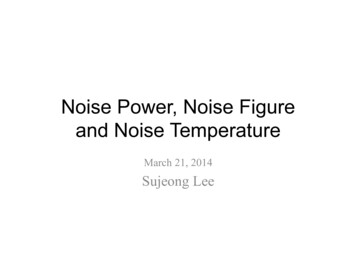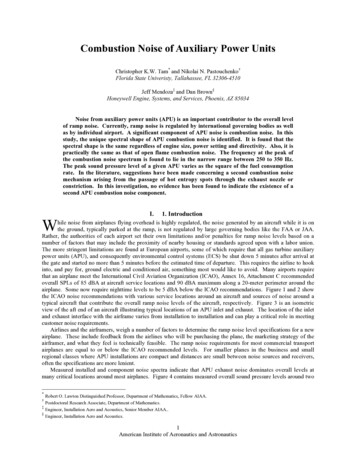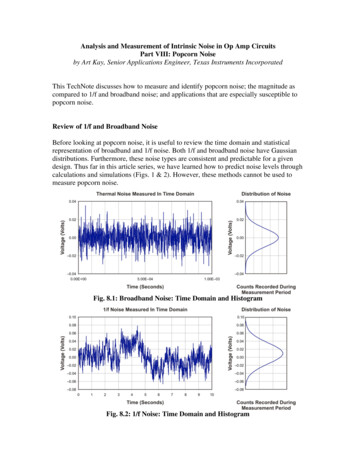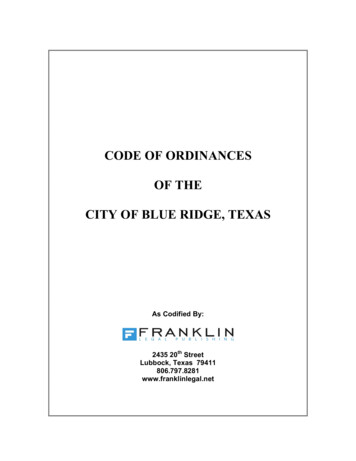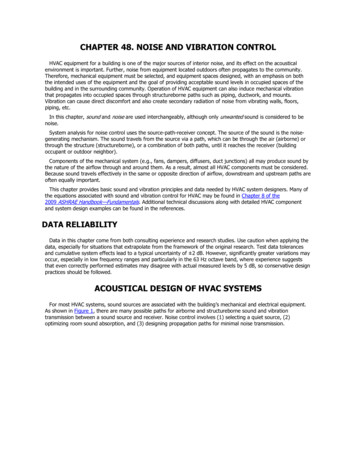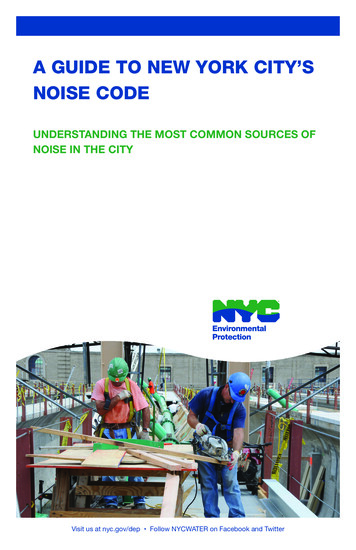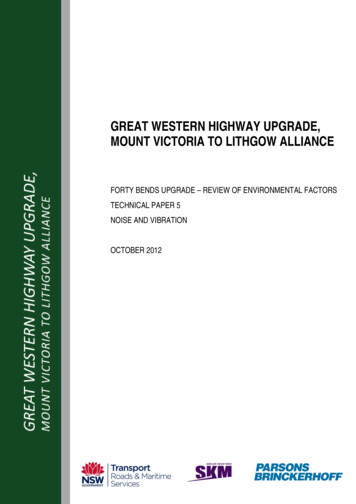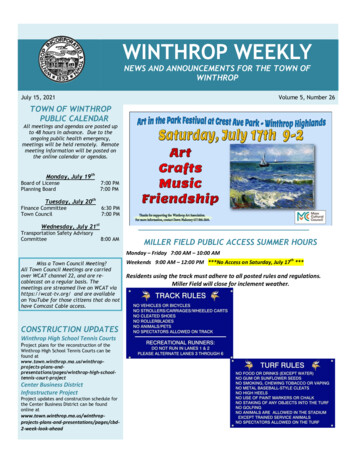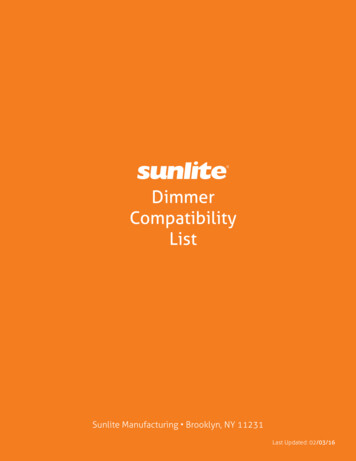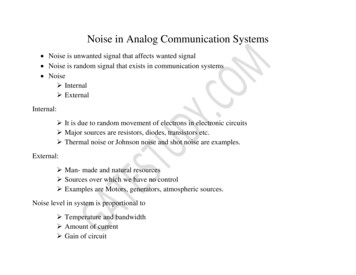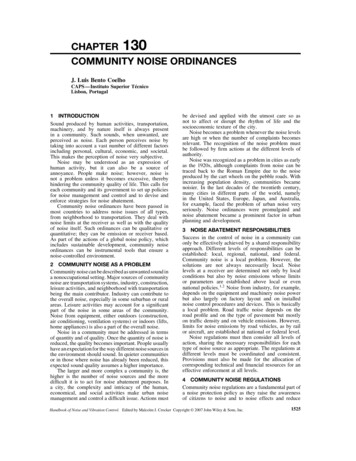
Transcription
CHAPTER 130COMMUNITY NOISE ORDINANCESJ. Luis Bento CoelhoCAPS—Instituto Superior TécnicoLisbon, Portugal1 INTRODUCTIONSound produced by human activities, transportation,machinery, and by nature itself is always presentin a community. Such sounds, when unwanted, areperceived as noise. Each person perceives noise bytaking into account a vast number of different factorsincluding personal, cultural, economic, and societal.This makes the perception of noise very subjective.Noise may be understood as an expression ofhuman activity, but it can also be a source ofannoyance. People make noise; however, noise isnot a problem unless it becomes excessive, therebyhindering the community quality of life. This calls foreach community and its government to set up policiesfor noise management and control and to devise andenforce strategies for noise abatement.Community noise ordinances have been passed inmost countries to address noise issues of all types,from neighborhood to transportation. They deal withnoise limits at the receiver as well as with the qualityof noise itself. Such ordinances can be qualitative orquantitative; they can be emission or receiver based.As part of the actions of a global noise policy, whichincludes sustainable development, community noiseordinances can be instrumental tools that ensure anoise-controlled environment.2 COMMUNITY NOISE AS A PROBLEMCommunity noise can be described as unwanted sound ina nonoccupational setting. Major sources of communitynoise are transportation systems, industry, construction,leisure activities, and neighborhood with transportationbeing the main contributor. Industry can contribute tothe overall noise, especially in some suburban or ruralareas. Leisure activities may account for a significantpart of the noise in some areas of the community.Noise from equipment, either outdoors (construction,air conditioning, ventilation systems) or indoors (lifts,home appliances) is also a part of the overall noise.Noise in a community must be addressed in termsof quantity and of quality. Once the quantity of noise isreduced, the quality becomes important. People usuallyhave an expectation for the way different noise sources inthe environment should sound. In quieter communitiesor in those where noise has already been reduced, thisexpected sound quality assumes a higher importance.The larger and more complex a community is, thehigher is the number of noise sources and the moredifficult it is to act for noise abatement purposes. Ina city, the complexity and intricacy of the human,economical, and social activities make urban noisemanagement and control a difficult issue. Actions mustbe devised and applied with the utmost care so asnot to affect or disrupt the rhythm of life and thesocioeconomic texture of the city.Noise becomes a problem whenever the noise levelsare high or when the number of complaints becomesrelevant. The recognition of the noise problem mustbe followed by firm actions at the different levels ofauthority.Noise was recognized as a problem in cities as earlyas the 1920s, although complaints from noise can betraced back to the Roman Empire due to the noiseproduced by the cart wheels on the pebble roads. Withincreasing population density, communities becamenoisier. In the last decades of the twentieth century,many cities in different parts of the world, namelyin the United States, Europe, Japan, and Australia,for example, faced the problem of urban noise veryseriously. Noise ordinances were promulgated andnoise abatement became a prominent factor in urbanplanning and development.3 NOISE ABATEMENT RESPONSIBILITIESSuccess in the control of noise in a community canonly be effectively achieved by a shared responsibilityapproach. Different levels of responsibilities can beestablished: local, regional, national, and federal.Community noise is a local problem. However, thesolutions are not always necessarily local. Noiselevels at a receiver are determined not only by localconditions but also by noise emissions whose limitsor parameters are established above local or evennational policies.1,2 Noise from industry, for example,depends on the equipment and machinery noise powerbut also largely on factory layout and on installednoise control procedures and devices. This is basicallya local problem. Road traffic noise depends on theroad profile and on the type of pavement but mostlyon traffic density and on vehicle emissions. However,limits for noise emissions by road vehicles, as by railor aircraft, are established at national or federal level.Noise regulations must then consider all levels ofaction, sharing the necessary responsibilities for eachtype of noise source as appropriate. The regulations atdifferent levels must be coordinated and consistent.Provisions must also be made for the allocation ofcorresponding technical and financial resources for aneffective enforcement at all levels.4 COMMUNITY NOISE REGULATIONSCommunity noise regulations are a fundamental part ofa noise protection policy as they raise the awarenessof citizens to noise and to noise effects and reduceHandbook of Noise and Vibration Control. Edited by Malcolm J. Crocker Copyright 2007 John Wiley & Sons, Inc.1525
1526COMMUNITY AND ENVIRONMENTAL NOISE AND VIBRATION PREDICTION AND CONTROLthe production of noise in many circumstances. Theyestablish the basic criteria for the acoustical quality ofthe environment and set the objective noise values thatdefine the noise abatement purposes. These regulationsrequire actions from lower levels of government, fromtransport authorities, and from other bodies responsiblefor noise sources and noise emissions. They establishlaw compliance mechanisms and penalties, making ita platform for the common citizen to be aware of hisduties and to demand his rights.Noise ordinances may define the excessive noiseby its character or nature. They may prohibit certain activities, restrict activities to certain hours of theday, require permits or licenses for noisy activities,or merely define noise zones. These are qualitativeordinances. These ordinances do not include quantitative criteria and may therefore pose some difficultiessuch as vagueness, as they are generally subjectivein nature. Community noise ordinances usually tookthis form in the past. They can be recommended asa first approach to raise the issues of self-regulationand noise control or for those communities where thenoise problems are either not too severe or are causedby locally well-controlled noise sources. Costs associated with the enforcement of qualitative regulations areusually relatively low since the corresponding technical requirements do not have to be too sophisticated.Quantitative ordinances, on the other hand, establishnumerical values as limits for the noise levels producedor received. Criteria are defined and standards arerequired for measurement or prediction of noise.Maximum permitted noise levels are generally expressedin A-weighted sound pressure levels and may vary fordifferent areas of the community and for different typesof noise sources as appropriate. This type of ordinanceis recommended for communities where the noiseproblems are more complex or where a more stringentmanagement of noise must be met. Good results, though,require that technical facilities (know-how, acousticaltechnicians and engineers, measuring apparatus) eitherexist or are created, and such costs must be envisagedwhen the ordinance is being drafted. Qualitative andquantitative ordinances are both valuable, although acomposition of both features usually prove to lead to themost effective noise ordinance contents.Noise ordinances can be of two types: emissionlaws or receiver-based laws. Emission laws andregulations regulate noise at the source, by establishinglimits to the amount of noise emitted by equipment.Maximum permissible noise levels are defined for eachtype of machinery, vehicle, transportation, or activity.Receiver-based laws regulate the noise levels receivedat a particular site. Limits are defined for the noiseexposure at specific locations. These limits are usuallyrelated to the use of the property the sound is entering.These ordinances set zoning performance standards fornew noise sources. Noise zoning is then used by localauthorities for land-use planning.In the 1990s, the World Health Organization (WHO)published guideline target values to be adopted forprotection against noise.3,4 The WHO recommendedthe following: (1) to protect the majority of peoplefrom being moderately annoyed during the daytime, theoutdoor A-weighted sound pressure level (LAeq ) shouldnot exceed 50 dB, (2) to protect the majority of peoplefrom being seriously annoyed during the daytime inoutdoor living areas the A-weighted sound pressure level(LAeq ) should not exceed 55 dB and (3) at nighttimeoutside sound pressure level should not exceed 45 dB inresidential areas, so that the recommended A-weightedsound pressure level of 30 dB inside bedrooms with thewindows open can be met. The WHO also suggestsa limit of 60 dB for the maximum outdoor event Aweighted sound pressure level at night to protect peoplefrom sleep disruption.These values were recommended in the EuropeanGreen Paper on Future Noise Policy1 as objective noiselevels for all European Union (EU) member states.They have also been adopted in noise regulations inother parts of the world.5 New guidelines for theexposure to noise at night have been prepared recentlyby the WHO. A final draft was approved in late 2006,and a final publication is expected in 2007.5 COMMUNITY NOISE ORDINANCECOMPONENTSA community noise ordinance can be a precious instrument for dealing with noise at a local level. The qualityand the quantity of the overall noise are addressed, noisyactivities are regulated, noise limits are set, and responsible bodies and cost-effective noise abatement policies aredefined. It must first be determined, however, whether thelocal government concerned has enough authority to legislate on the noise matters, since its powers are delegatedpowers and its legislative authority is only that grantedby statutory or constitutional provisions.A well-written noise ordinance must cover a number of components in a concise, clear, and precise wayso as to address the local noise issues in as comprehensive a manner as possible to avoid misinterpretationand litigation. Vagueness, indefiniteness, and uncertainty should be prevented.A community noise ordinance starts by a declarationof policy, a comprehensive list of definitions of termsand technical references, and by establishing the powersand duties of the municipal agency or department havingthe lead responsibility for the ordinance (noise controlofficer).The rating index and its assessment method mustbe very clearly defined. The metrics most widely usedis the long-term A-weighted continuous equivalentsound pressure level, LAeq , since it yields a goodcorrelation with noise effects.6 The day–night averagenoise level, Ldn , is a 24-h A-weighted noise indexused in the United States. It is calculated from thevalues of LAeq during daytime and during nighttimewhere a 10-dB penalty is applied to sound occurringbetween 10 p.m. and 7 a.m. The European Directive2002/49/EC introduced the 24-h day–evening–nightlevel, Lden , also calculated from the values of LAeqduring the day period, during the evening period witha penalty of 5 dB and during the night period with apenalty of 10 dB, to be used by all EU member statesin strategic noise mapping and action plans.7 Other
COMMUNITY NOISE ORDINANCESindicators are used for the rating of road traffic noise orof aircraft noise in different countries. The ordinancemust also refer to impulsive, narrow-band, or otherrelevant acoustical characteristics and establish anycorresponding corrections to the rating index.Measurement and calculation procedures arerequired to follow the applying standards. Therecommendations and provisions set out in theInternational Organization for Standardization (ISO)1996 standard8 or equivalent [e.g., American NationalStandards Institute (ANSI)] are usual requisites. Noiseassessment location (by measurement or calculation)and other relevant conditions (time intervals, emissionor received noises) not covered by applying standardsshould be included in the text of the ordinance.Reference time periods are defined, with theirstart and end hours clearly established, if not setat national level. Some countries consider only tworeference periods, daytime and nighttime, whereasothers consider a third one, a rest or evening period.The noise ordinance usually defines noise zonesaccording to the land uses and noise-sensitive activities. Corresponding noise limit values are stipulatedfor each reference time interval. The most stringentlimits apply to residential, school, hospital, or leisureareas. It is recommended that different noise zones arecreated with noise limits in steps of 5 dB. Experienceswith courser grades, with 10-dB steps, for example,have proved less practical and less effective.Restrictions on noisy activities, musical instruments,and public address systems, construction, machineoperation, traffic (e.g., heavy goods vehicles andaircraft) should be defined for the different noisesensitive zones, together with criteria regarding themaximum permitted noise levels and the applicablehours. All such activities have to be clearly defined so asto avoid alternative interpretations and future litigation.Restrictions are set for construction of some typesof buildings (residence, school, hospital, or similarstructure) and for land-use planning purposes so thatthe noise limits for each noise zone can be ensured.Similar types of restrictions are set for new outdooror indoor recreational and leisure areas for the samereason. Plans for construction of new transportationsystems or expansion of the capacity of existing onesin or near noise-sensitive zones may also be restricted,unless the necessary noise abatement measures areincluded to ensure that the noise levels in the zonewill be within the prescribed limits.The noise limits usually apply to the overall noiselevels, but they may refer to noise from the differentprimary noise sources (industry, road traffic, railwaytraffic, and air traffic). Limits on noise emissions frommachinery, construction work, and industry can be setsince they can be well controlled at local level. Thesenoisy activities are usually licensed by the municipalities. Limits on noise from transportation are usuallyset at the receiver. This is an area where coordination with transport authorities and with regulationsat national level will prove most fruitful, given thelimitations of the local legislative powers regarding1527nationwide transport systems (e.g., airports, highways,and national railways).Some restrictions (access traffic, activities) mayhave economic and societal prices, and the communityshould decide what level of cost–benefit is mostappropriate. A number of experiences with severetraffic restrictions in some European cities have metwith the opposition of residents who abandoned thearea allegedly due to a decrease in economic activityand to the fear of a drop in real estate values.Responsibilities for the measurement and assessmentof noise should be set. Duties of the noise control agencyor officer are defined to review the projects that mayresult in the production of sound, to inspect any placeor situation suspected of violating any provision of theordinance, and to investigate and pursue possible violations of the ordinance. Public education and informationprograms should be required or suggested. Participationof public-interest groups is mandatory in some countriesand recommended in others. Noise mapping and noiseaction planning are usually required to integrate the landuse plans and long-term urban development plans wherethese instruments are operative.Enforcement provisions must be clearly set out. Thenoise control officer or agency must rely on a welltrained team of municipal or county engineers whomust be technically prepared and equipped to reviewrelevant acoustical projects, to proceed with inspections, and to issue notices of violation and abatementorders (these are more effective if such orders includeadvice or recommendations on types of possible solutions or remedies). Although they do not need to beexperts or even hold a college degree, some trainingon basic acoustics, sound radiation and propagation,and acoustical measurements should be provided tothe technical staff. They must have a good knowledgeof the existing measurement and calculation standardsand of the measuring apparatus. The higher the quantitative nature of the ordinance, the higher is the technical requirement and the associated cost.Fines and penalty actions must be well defined. Theordinance must state the explicit time criteria and goalsfor the full compliance of the regulations: hours of restrictions and periods of time to correct the violation or toimplement the necessary remedies or abatement measures. Exceptions (e.g., emergencies) and variances (timeto comply in specific conditions) should also be included.The document Model Community Noise ControlOrdinance issued by the U.S. Environmental ProtectionAgency (EPA) in the 1970s, describes a generic layoutof a community noise ordinance to be adopted in U.S.communities.9 Model noise ordinances were thereafterdrafted in various U.S. states (e.g., Alaska, California,and New Jersey) aimed at their municipalities.The community may publish, as a support to thenoise ordinance, technical and information guides oncommunity noise with more detailed definitions, basicexplanations on noise production, noise sources, andeffects of noise on practical measures and proceduresto reduce it and on how the citizens can seek abatementorders. This has been followed in many cities of various countries with great success. Information regarding
1528COMMUNITY AND ENVIRONMENTAL NOISE AND VIBRATION PREDICTION AND CONTROLnoise and noise effects is never too much but shouldbe provided at a level that can be fully understood bythe target population, meaning that different brochuresor documents, technical and nontechnical, may berequired. Community noise ordinances have beeninstruments for the management and control of noisein local communities of many countries worldwide.6 THE U.S. NOISE POLICYThe need for a noise policy in the United States was firstrecognized in 1967. In 1969, the National EnvironmentalPolicy Act (NEPA) was approved.10 The NEPA is a basicnational charter for protection of the environment inthe United States. NEPA mandated the environmentalimpact assessment process, and noise is one of the manyenvironmental attributes that must be considered.In 1972, the Noise Control Act (NCA 72) wasapproved by the U.S. Congress.11 The NCA 72 waspassed specifically to address environmental noise. TheNCA 72 stated that it is “the policy of the United Statesto promote an environment for all Americans freefrom noise that jeopardizes their health or welfare.”In the act, the U.S. Congress recognized that the“primary responsibility for the control of noise restswith state and local governments” while “federal actionis essential to deal with major noise sources.”The responsibility for implementing NCA 72was assigned to the EPA.12 This was to be theleading federal agency in charge of coordinating theprograms of all federal agencies dealing with noisecontrol. However, in the early 1980s EPA was nolonger involved with noise control regulations. 12,13About a dozen federal agencies have since beenresponsible for the development, formulation andimplementation of the U.S. noise policies together withthe corresponding bodies of state and local authorities.The policies of these agencies have not always beencoordinated, leading to some lack of consistency innoise requirements, which usually apply separately todifferent noise source emissions.14The aircraft noise policy of the Federal AviationAdministration (FAA), applicable to civilian-operatedairports, has been very effective. The Aircraft NoiseAbatement Act of 1968 (later modified by the NCA72) directed the FAA to establish standards and regulations for aircraft noise.15 Aircraft noise certificationby FAA was required by the 1969 Federal AviationRegulations.16 This was followed by the 1976 AviationNoise Abatement Policy17 and by the Aviation Safetyand Noise Abatement Act of 1979.18 In 2000, the Aviation Noise Abatement Policy was revised and variousissues from aviation noise assessment to promotionof compatible uses of impacted land were outlined.The FAA and the Department of Defense adopted theannual A-weighted day–night average sound pressurelevel of 65 dB as the level for action regarding aircraftnoise abatement in residential areas near an airport.19Road traffic noise has been regulated by theFederal Highway Administration (FHWA) since it wasmandated by the Highway Federal Act of 1970 todevelop noise standards for mitigating highway trafficnoise and by the NCA 72 to enforce the noise emissionstandards for vehicles that were to be defined bythe EPA. A number of documents were publishedsince the 1970s. The Procedures for Abatement ofHighway Traffic Noise and Construction Noise setlimits for levels of noise along highways and definedcriteria and the responsible bodies for noise abatementprocedures.20 The FHWA criterion for action to protectresidents near a federally funded highway project is thenoise action level of 67 dB corresponding to the peaktraffic hour LAeq1h . Land-use planning near highwaysis, however, left to state and local governments.The U.S. EPA recommended in 1974 that theoutdoor A-weighted day–night sound pressure levelshould be kept below 55 dB in residential areas. Thisvalue has also been adopted by the Federal EnergyRegulatory Commission (FERC) to protect residentsnear some industrial installations.The policy for noise protection is now basicallydefined at state or local level since it was recognizedas a more efficient approach. Nevertheless, for communities impacted by a combination of different sources,the issue is a difficult one since a variety of limits andmetrics apply. A large number of U.S. cities and townshave their own community noise ordinances.21 The firstknown local noise ordinance regarding noise limits wasadopted by Chicago around 1955. These were zoningregulations aimed primarily at industry and targetedat 61 dB for sound entering other business areas and54 dB for sound entering residential areas during dayor night. The New York City noise ordinance is currently undergoing a major revision. Most communitynoise ordinances in the United States now apply thegeneral strategy set out in the EPA’s Framework forCommunity-Based Environmental Protection.22The need to revise the U. S. national noise policyis now being considered seriously.13,14,23,24 There is aneed to unify noise protection criteria at the nationallevel and to reactivate a lead agency responsible fornoise policy and control. A reformulation of the U.S.noise policy can be expected in the near future.217 THE EUROPEAN CHALLENGENoise regulations were passed in many European countries and cities since the late 1970s. They dealt withdifferent aspects of noise from transportation, equipment, neighborhood, or leisure activities. Most definednoise-sensitive zones, depending on the different landuses, defined associated noise limits for day and fornight periods, and established restrictions on traffic andon noise-producing activities.Environmental noise is addressed at the Europeanlevel through a wide range of instruments.25 Variousdirectives regarding noise emissions from differentsources, such as motor vehicles, railway systems,aircraft, household appliances, and outdoor machinery,have been approved since the early 1970s.Directive 86/594/EEC was passed in 1986 regardingnoise labeling of household appliances.26 Directive2000/14/EC lays down noise provisions to reduce thenoise emitted by outdoor equipment and requirementsfor harmonization of noise emission limits and standards,
COMMUNITY NOISE ORDINANCESof conformity assessment procedures, and of noise levelmarking.27 Directive 2003/44/EC, which amends theprevious recreational craft Directive 94/25/EC and tookeffect progressively from 2005, establishes requirementsregarding noise emission limit values for recreationalcraft.28The directives on noise emission from new motorvehicles have been a success story. The first Europeanharmonized noise requirements for road vehicles wereintroduced in 1970 by Directive 70/157/EEC relatingto the permissible noise level and the exhaust systemof four-wheel motor vehicles.29 Noise limits for newcars first defined in Directive 77/212/EEC were madeincreasingly more stringent until the most recent one,92/97/EEC.29 The decrease in the prescribed maximumallowed noise levels ranged from 6 dB for passengercars to 10 dB for heavy trucks. Directive 97/24/EC30sets permissible noise levels for two- and three-wheelvehicles and their exhaust systems, and Directive2001/43/EC31 deals with tire rolling noise.European legislation has addressed railway noise atsource through directives on railway interoperabilityfor high-speed rail (Directive 96/48/EC32 ) and forconventional rail (Directive 2001/16/EC33 ). Technicalspecifications were approved in 2002, setting out noiseemission limits for high-speed trains at different speeds.Noise emission limitations from civil aircraft havebeen in force since 1980 (Directive 80/51/EEC.34 )Directive 92/14/EEC of 1992, based on standards ofthe International Civil Aviation Organization (ICAO),banned the noisiest aircraft (Chapter 2 of Annex 16 ofICAO) from European airports.35 In 2002, Directive2002/30/EC established rules and procedures withrespect to the introduction of noise-related operatingrestrictions at EU airports.36 It further required thatresults of the implementation of this directive bereported no later than 2007.In the mid-1990s various studies were conducted as astarting point of a new directive on environmental noise.It was found37 that about 20% of the European populationwas exposed to A-weighted sound pressure levels of65 dB or above, mainly from transportation. In 1996,the European Commission produced the Green Paperon Future Noise Policy.1 Following the publication ofthis document, a new framework for noise policy, basedon shared responsibility between the European Union,national, and local authorities was defined.The Environmental Noise Directive (END)2002/49/EC was published in 2002 on the basis of theGreen Paper recommendations to address noise issuesand to define a “common approach for all European countries in order to avoid, prevent or reduce on a prioritizedbasis the harmful effects, including annoyance, due toexposure to environmental noise”.7 The END defines thebasic principles of a harmonized European noise policy.It requires the assessment of the environmental noise,both overall and from major noise sources, such as transportation and industry, the number of people exposed todifferent noise levels, action plans for reduction of noise1529exposure, communication with the public, and communication between the European Commission and the member states. No noise limits were included as this is left toeach country or local community.A noise expert network was set up in order to assistand provide advice to the European Commission priorto and after the publication of the END. Differentworking groups of experts from different memberstates were created to deal with emissions from noisesources and with noise effects and perception. Twoworking groups still meet regularly: Assessment ofExposure to Noise (WG-AEN) and Health and SocioEconomic Aspects (WG-HSEA).The European Directive 2002/49/EC requires thecompetent authorities to draw strategic noise mapsfor the assessment of noise from major transportinfrastructures and in communities with more than100,000 inhabitants.7 Action plans are required andshould be designed to manage noise issues and effects,including noise reduction, if necessary. Two stages aredefined. In the first stage, strategic noise maps for allagglomerations with more than 250,000 inhabitants,major airports with more than 50,000 movementsper year, major roads with more than 6,000,000vehicles per year, and railways with more than 60,000passages per year must be completed by June 2007.The corresponding action plans must be finished byJuly 2008. The second stage corresponds to otheragglomerations with more than 100,000 inhabitants,major roads with more than 3,000,000 vehicles peryear, and railways with more than 30,000 passagesper year. Strategic noise maps must be completed byJune 2012 and action plans by July 2013. Noise mapsand action plans are to be reviewed every 5 years.All EU directives are transposed into nationallegislations of the European member states. Their ownnoise ordinances at national, regional, or municipallevels that address noise zoning, noise limits, and noiseabatement38 incorporate the growing harmonized noisecriteria and procedures.8 THE EXPERIENCE IN JAPANEnvironmental noise policies in Japan started in 1967,and in 1968 the first Noise Regulation Law wasapproved and later amended in 1995 and in 2000.39The Environmental Quality Standards for Noise40were first defined in May 1971, based on Article9 of the Basic Law for Environmental PollutionControl. Limit noise values were stipulated for twotypes of areas: general areas and roadside areas.General limits for the A-weighted sound pressure levelwere established at 35 dB during nighttime for quietneighborhoods and at 60 dB during daytime for areaswith a considerable number of dwellings but whichincluded commerce and industrial uses. Limits forroadside areas were 5 to 10 dB higher depending onvarious factors such as the number of road lanes. Inaccordance with the provisions of Article 16 of theBasic Environment Law (Law No. 91) of 1993, thenoise limi
sound pressure level, L Aeq, since it yields a good correlation with noise effects.6 The day-night average noise level, L dn, is a 24-h A-weighted noise index used in the United States. It is calculated from the values of L Aeq during daytime and during nighttime where a 10-dB penalty is applied to sound occurring between 10 p.m. and 7 a.m.
